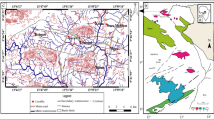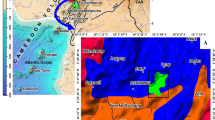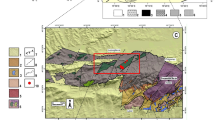Abstract
In the deep subsurface of the northeast German basin products of extensive volcanism are present that formed during the waning phase of the Variscan orogeny (Permian–Carboniferous boundary). Large volumes (≥48,000 km3) of dominantly felsic magma were emplaced in the northern foreland of the Variscan mountains in a terrestrial semi-arid environment. Most of these units were inferred by previous authors to represent the products of explosive volcanic eruptions such as ignimbrites. However, a detailed analysis of the volcanic texture and lithofacies association shows that most units are best interpreted as coherent lavas emplaced either as extrusive units or as shallow intrusions, with important implications for the reconstruction of the paleo-environment. This study shows that detailed textural examination of drill cores provide important observations, which can be applied as criteria for the interpretation of the mode of volcanic eruptions. Furthermore, phenocryst logging and geochemical fingerprinting based on immobile element ratios can be employed for the classification and discrimination of individual emplacement units.








Similar content being viewed by others
References
Allen RL (1988) False pyroclastic textures in altered silicic lavas, with implications for volcanic-associated mineralization. Econ Geol 83:1424–1446
Allen SR, McPhie J (2003) Phenocryst fragments in rhyolitic lavas and lava domes. J Volcanol Geotherm Res 126:263–283
Arthaud F, Matte P (1977) Late Paleozoic strike-slip faulting in southern Europe and Northern Africa: results of right-lateral shear zone between the Appalachians and the Urals. Geol Soc Am Bull 88:1305–1320
Awdankiewicz M, Breitkreuz C, Ehling B-C (2004) Emplacement textures in Late Palaeozoic andesite sills of the Flechtingen-Roßlau Block, north of Magdeburg (Germany). In: Breitkreuz C, Petford, N (eds) Physical geology of high-level magmatic systems. Geol Soc, Lond Spec Publ, vol 234, pp 51–66
Barrett TJ, MacLean WH (1994) Chemostratigraphy and hydrothermal alteration in exploration for VHMS deposits in Greenstones and younger volcanic rocks. In: Lentz DR (ed) Alteration and alteration processes associated with ore-forming systems, vol 11: Short Course Notes, Geol Assoc Can, pp 433–467
Benek R, Paech HJ, Schirmer B, (1973) Zur Gliederung der permosilesischen Vulkanite der Flechtinger Scholle. Z geol Wiss 1:867–878
Benek R, Kramer W, McCann T, Scheck M, Negendank JFW, Korich D, Huebscher HD, Bayer U (1996) Permo-Carboniferous magmatism of the Northeast German Basin. Tectonophys 266:379–404
Best MG, Christiansen EH (1997) Origin of broken phenocrysts in ash-flow tuffs. Geol Soc Am Bull 109:63–73
Branney MJ, Kokelaar P (1992) A reappraisal of ignimbrite emplacement; progressive aggradation and changes from particulate to non-particulate flow during emplacement of high-grade ignimbrite. Bull Volcanol 54:504–520
Branney M, Kokelaar P (2002) Pyroclastic density currents and the sedimentation of ignimbrites. Geol Soc Lond Mem 27:1–143
Brecht G (1999) Authigene Phyllosilikate in permokarbonen SiO2-reichen Vulkaniten Ostdeutschlands. Berl Geowiss Abh, Reihe A, 201, Berlin, pp 1–181
Breitkreuz C, Kennedy A (1999) Magmatic flare-up at the Carboniferous/Permian boundary in the NE German Basin revealed by SHRIMP zircon ages. Tectonophys 302:307–326
Duffield WA, Dalrymple GB (1990) The Taylor Creek Rhyolite of New Mexico: a rapidly emplaced field of lava domes and flows. Bull Volcanol 52:475–487
Fink JH, Bridges NT, Grimm RE (1993) Shapes of Vesuvian "Pancake" domes imply episodic emplacement and silicic composition. Geophys Res Lett 20:261–264
Franz G, Breitkreuz C, Coyle DA, El Hur B, Heinrich W, Paulick H, Pudlo D, Smith R, Steiner G (1997) The alkaline Meidob volcanic field. J Afr Earth Sci 25:263–291
Gebhardt U, Schneider J, Hoffmann N (1991) Modelle zur Stratigraphie und Beckenentwicklung im Rotliegenden der Norddeutschen Senke. Geol Jb A 127:405–427
Geißler M, Breitkreuz C (2004a) Vulkanische Faziestypen und ihre zeitlich-räumliche Verteilung im Permokarbon des Zentraleuropäischen Beckensystems. GeoLeipzig 2004, DGG Schriftr, Heft 34, S. 42
Geißler M, Breitkreuz C (2004b) Volcano-topographic hiati: an important stratigraphic element in the Late Paleozoic evolution of the Central European Basin System.- 32 Int Geol Congr, Firence, Abstract Volume
Henry CD, Wolff JA (1992) Distinguishing strongly rheomorphic tuffs from extensive silicic lavas. Bull Volcanol 54:171–186
Hoffmann N, Pokorski J, Lindert W, Bachmann G H (1997) Rotliegend stratigraphy, palaeogeography and facies in the eastern part of the Central European Basin. Prac Panstwow Inst Geol Warsaw, vol VII, pp 75–86
Hoth K, Huebscher H-D, Korich D, Gabriel W, Enderlein F (1986) Abschlußbericht - Autunvulkanite Norden DDR (unpubl.), VEB Geol Forsch Erkund, Freiberg, pp 1–87
Hoth K, Huebscher HD, Korich D, Gabriel W, Enderlein F (1993a) Die Lithostratigraphie der permokarbonischen Effusiva im Zentralabschnitt der Mitteleuropäischen Senke - Der permokarbonische Vulkanismus im Zentralabschnitt der Mitteleuropäischen Senke, Teil 1. Geol Jb A 131:179–196
Hoth K, Rusbült J, Zagora K, Beer H, Hartmann O (1993b). Die tiefen Bohrungen im Zentralabschnitt der mitteleuropäischen Senke - Dokumentation für den Zeitabschnitt 1962–1990. Schriftenr f Geowiss 2:7–145
Jackowicz E (1994) Persmkie skały wulkaniczne północnej części monokliny przedsudeckiej. Pr Pánstw Inst Geol 145:1–47
Kirstein LA, Hawkesworth CJ, Garland FC (2001) Felsic lavas or rheomorphic ignimbrites: is there a chemical distinction? Contr Min Petrol 142:309–322
Kobberger G, Schmincke H-U (1999) Deposition of rheomorphic ignimbrite D (Mogán Formation), Gran Canaria, Canary Islands, Spain. Bull Volcanol 60:465–485
Korich D (1992a) Zu Stoffbestand und Genese der sauren und intermediären Vulkanite des Darß-Uckermark-Eruptivkomplexes in Mecklenburg-Vorpommern. Z Geol Wiss 20:337–350
Korich D (1992b) Zur Vulkanologie und Korrelation der permosilesischen Vulkanite im Darß-Uckermark-Eruptivkomplex/Nordostdeutschland. Z geol Wiss 20:467–473
Lorenz V, Haneke J (2004) Relationship between diatremes, dykes, sills, laccoliths, intrusive-extrusive domes, lava flows, and tephra deposits with unconsolidated water-saturated sediments in the Late Variscan intermontane Saar-Nahe-Basin, SW Germany. In: Breitkreuz C, Petford, N (eds) Physical geology of high-level magmatic systems. Geol Soc, London Spec Publ, vol 234, pp 75–124
MacLean WH (1990) Mass change calculations in altered rock series. Min Dep 25:44–49
MacLean WH, Kranidiotis P (1987) Immobile elements as monitors of mass transfer in hydrothermal alteration: Phleps Dodge massive sulfide deposit, Matagami, Quebec. Econ Geol 82:951–962
Maliszewska A, Kiersnowski H, Jackowicz E (2003) Wulkanoklastyczne osady czerwonego spągowca dolnego na obszarze wielkopolski. Pr Pánstw Inst Geol 179:1–59
Manley CR (1996) In situ formation of welded tuff-like textures in the carapace of a voluminous silicic lava flow, Owyhee County, SW Idaho. Bull Volcanol 57:672–686
Manley CR, Fink JH (1987) Internal textures of rhyolite flows as revealed by research drill hole. Geology 15:549–552
Marx J, Huebscher HD, Hoth K, Korich D, Kramer W (1995) Vulkanostratigraphie und Geochemie der Eruptivkomplexe. In: Plein E (ed) Norddeutsches Rotliegendbecken - Rotliegend Monographie Teil II, Courier Forschungsinstitut Senkenberg, vol 183, pp 54–83
McArthur AN, Cas RAF, Orton GJ (1998) Distribution and significance of crystalline, perlitic and vesicular textures in the Ordovician Garth Tuff (Wales). Bull Volcanol 60:260–285
McCann T (1996) The North Celtic Sea reflector; a possible Caledonian basement structure, offshore southern Ireland. Tectonophys 266:361–377
McPhie J (1986) Primary and redeposited facies from a large-magnitude, rhyolithic, phreatomagmatic eruption: Cana Creek Tuff, Late Carboniferous, Australia. J Volc Geotherm Res 28:319–350
McPhie J, Doyle M, Allen R (1993) Volcanic textures. A guide to the interpretation of textures in volcanic rocks. Hobart, University of Tasmania, pp 1–198
Milner SC, Duncan AR, Whittingham AM, Ewart A (1995) Trans-Atlantic correlation of eruptive sequence and individual silicic volcanic units within the Paraná-Etendeka igneous province. J Volc Geotherm Res 69:137–157
Mock A, Ehling B-C, Breitkreuz C (2005) Anatomy of a laccolith complex—geometry and texture of porphyritic rhyolites in the Permocarboniferous Halle Volcanic Complex (Germany). N Jb Geol Paläont Abh (in press)
Orth K, McPhie J (2003) Textures formed during emplacement and cooling of a Palaeoproterozoic, small-volume rhyolitic sill. J Volc Geotherm Res 128:341–362
Pankhurst RJ, Leat PT, Sruoga P, Rapela CW, Márquez M, Storey BC, Riley TR (1998) The Chon Aike province of Patagonia and related rocks in West Antarctica: a silicic large igneous province. J Volc Geotherm Res 81:113–136
Rieke H, McCann T, Krawczyk CM, Negendank JFW (2003) Evaluation of controlling factors on facies distribution and evolution in an arid continental environment: an example from the Rotliegend of the NE German Basin. Geol Soc Lond Spec Publ, vol 208, pp 71–94
Romer RL, Förster HJ, Breitkreuz C (2001) Intracontinental extensional magamtism with a subduction fingerprint: the late Carboniferous Halle Volcanic Complex (Germany). Contr Min Petrol 141:201–221
Schneider J, Gebhardt U (1993) Litho- und Biofaziesmuster in intra- und extramontanen Senken des Rotliegend (Perm, Nord- und Ostdeutschland). Geol Jb A 131:57–98
Smith RL (1960) Ash flows. Geol Soc Am Bull 71:795–841
Sparks RSJ, Walker GPL (1977) The significance of vitric-enriched air-fall ashes associated with crystal-enriched ignimbrites. J Volcanol Geotherm Res 2:329–341
Sparks RSJ, Young SR (2002) The eruption of Soufrière Hills Volcano, Montserrat (1995–1998): overview and scientific results. Geol Soc Lond Mem 21:45–70
Streck MJ, Grunder AL (1995) Crystallization and welding variations in a widespread ignimbrite sheet; the Rattlesnake Tuff, eastern Oregon, USA. Bull Volcanol 57:151–169
Swanson SE (1977) Relation of nucleation and crystal-growth rate to the development of granitic textures. Am Mineral 62:966–978
Walker GPL (1973) Lengths of lava flows. Phil Trans R Soc Lond A 274:107–118
Ziegler P (1990) Geological atlas of western and central Europe. Shell Int Petrol Mij dist Geol Soc Publ House Bath, 2nd edn, pp 1–239
Acknowledgements
This research would not have been possible without the generous access to core, thin sections and unpublished reports provided by Erdöl Erdgas GmbH (Berlin). The permission to publish these results is gratefully acknowledged. The authors would like to emphasis the contribution of K. Hoth, D. Huebscher, D. Korich and others to the understanding of Late Paleozoic volcanism in NE Germany within the framework of the hydrocarbon exploration program of the German Democratic Republic between the 1970s and 1990s. The cooperation with the Geological State Surveys of Mecklenburg-Vorpommern and Brandenburg is highly acknowledged. Discussions with M. Geißler contributed to our understanding of the CEBLIP volcanology. This research was supported by grants of the German Research Foundation (DFG) to CB. This paper benefited from the comments by L. Viereck-Götte and an anonymous reviewer.
Author information
Authors and Affiliations
Corresponding author
Rights and permissions
About this article
Cite this article
Paulick, H., Breitkreuz, C. The Late Paleozoic felsic lava-dominated large igneous province in northeast Germany: volcanic facies analysis based on drill cores. Int J Earth Sci (Geol Rundsch) 94, 834–850 (2005). https://doi.org/10.1007/s00531-005-0017-y
Received:
Revised:
Accepted:
Published:
Issue Date:
DOI: https://doi.org/10.1007/s00531-005-0017-y




